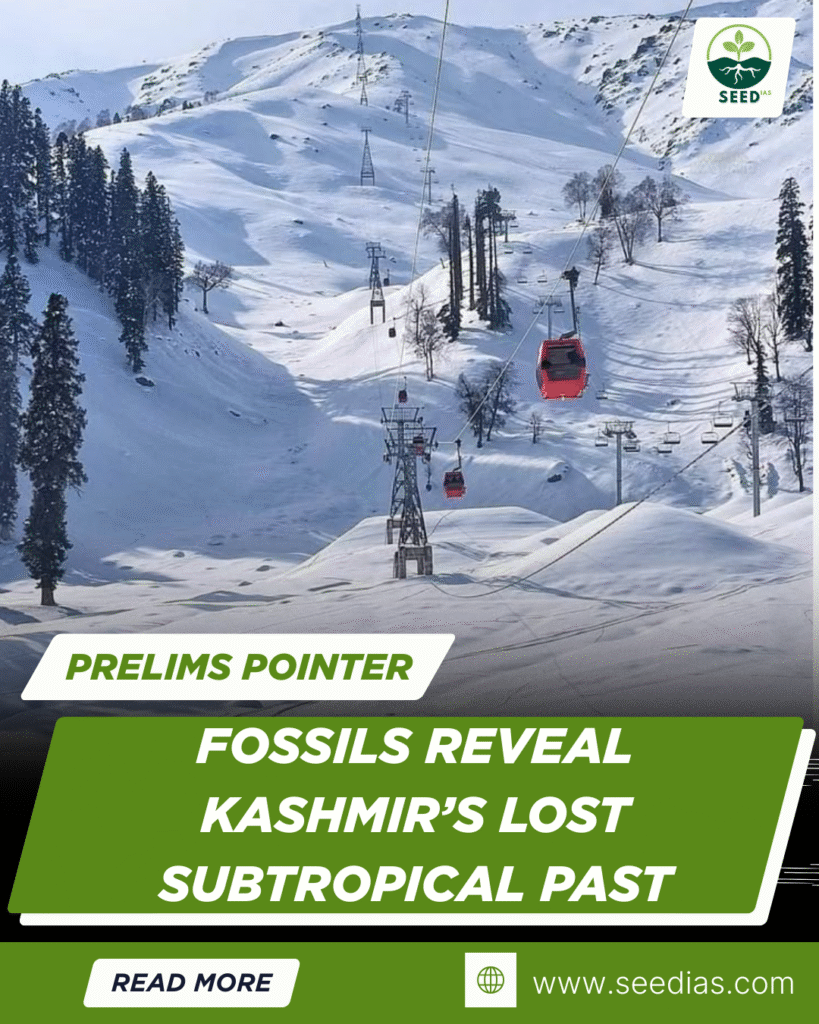Why in NEWS
A palaeobotanical study by scientists from the Birbal Sahni Institute of Palaeosciences (BSIP), Lucknow, has revealed that around 4 million years ago, the Kashmir Valley had a warm, humid subtropical climate—unlike its current cool, temperate conditions.
Key Concepts & Definitions
| Term | Definition |
|---|---|
| BSIP | Birbal Sahni Institute of Palaeosciences – premier Indian institute for fossil-based climate studies |
| CLAMP | Climate Leaf Analysis Multivariate Program – estimates past climate using fossil leaf traits |
| Coexistence Approach | Method comparing fossil species with modern relatives to infer ancient climate |
| Karewa Sediments | Geological deposits in Kashmir containing rich fossil records from the Neogene period |
About the Study and Techniques Used
| Aspect | Details |
|---|---|
| Why It Was Conducted | Fossil leaf samples showed subtropical traits inconsistent with current cold-temperate flora |
| Methods | CLAMP (leaf morphology) + Coexistence Approach (fossil-modern species comparison) |
| Fossil Source | Karewa sediment formations in Kashmir Valley |
| Findings | Presence of broadleaf fossil species typical of warm, humid subtropical forests |
Findings and Interpretation
| Factor | Description |
|---|---|
| Then | Subtropical climate with high rainfall and dense forests |
| Now | Alpine, coniferous vegetation with Mediterranean-like cool climate |
| Reason for Shift | Tectonic uplift of Pir Panjal Range disrupted monsoon flow, reducing rainfall and cooling the region |
Significance of the Findings
| Relevance | Insights |
|---|---|
| Climate Modelling | Links tectonics to long-term climate shifts and vegetation patterns |
| Monsoon & Glacial Study | Helps understand Himalayan monsoon history and glacial evolution |
| Ecosystem Sensitivity | Highlights how mountain ecosystems respond to geological and climatic changes |
| Policy Implications | Supports biodiversity conservation, disaster management, and sustainable development planning in ecologically sensitive regions |
In a Nutshell
Mnemonic: LEAF CLIMB
- Lush forests once in Kashmir
- Evidence from fossils
- Analysis using CLAMP & Coexistence
- Fossil–modern species match
- Climate shift due to tectonic uplift
- Loss of monsoon flow
- Impacts on biodiversity
- Modelling monsoon & glacial melt
- BSIP study boosts mountain climate knowledge
Prelims Practice Questions
- Which of the following techniques is used to reconstruct past climates using leaf fossils?
A. Radiocarbon Dating
B. Coexistence Approach
C. Isotope Hydrology
D. Bioindicator Tracking - The Karewa sediments of Kashmir are known for which of the following?
A. Uranium deposits
B. Marine fossils
C. Palaeobotanical fossil leaves
D. Volcanic ash layers - Which mountain range’s uplift played a key role in altering Kashmir’s ancient climate?
A. Zabarwan Range
B. Karakoram Range
C. Pir Panjal Range
D. Ladakh Range
Mains Practice Questions
- How can palaeobotanical studies like the recent Kashmir fossil study help us understand long-term climate change?
Discuss their relevance for policy in ecologically fragile areas. 15 marks - Examine how tectonic processes influence regional climate patterns with reference to the Pir Panjal uplift and its effects on Kashmir’s monsoon. 10 marks
Prelims Answer Key with Explanation
| Q. No | Answer | Explanation |
|---|---|---|
| 1 | B | Coexistence Approach uses fossil-modern species overlap for climate reconstruction |
| 2 | C | Karewa sediments are rich in fossil leaves studied for palaeoclimate |
| 3 | C | Pir Panjal Range uplift altered monsoon paths and reduced rainfall in Kashmir |
















